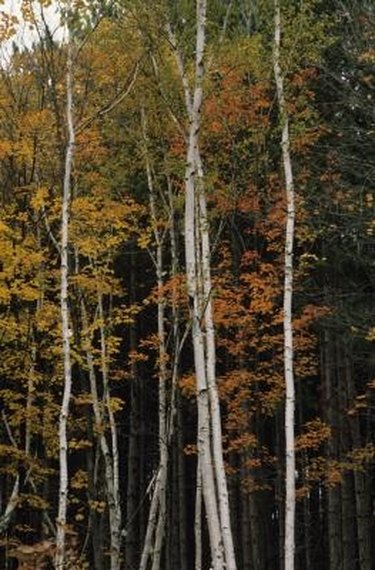
Curly maple is a variety of wood that is favored by musical instrument craftsmen. The wood is sought after but is not a type of maple. It refers to the patterning inside the wood. The grain forms into several different and unique patterns such as birdseye, tiger, quilted and other interesting grain effects. Curly maple tree identification requires you to kill the tree and cut into it. Curly maple usually comes from sugar maples, although other types of trees can also show the abnormality. It is possible to tell a birdseye maple before cutting into the tree, but the other formations are not as easy to spot.
Step 1
Find a sugar maple. If you know where one is terrific. If not, they are found across the northeastern states, into the mid-Atlantic States and over to the center of the U.S. They are the source of maple syrup. Curly maple is prevalent in Pennsylvania. Use a tree identification book to help you.
Video of the Day
Step 2
Look at the exterior of the tree. It should be a mature tree, since young trees do not exhibit signs of the unusual grain. The bark on a curly maple will be slightly bumpier than a regular sugar maple. It is generally gray to dark brown and quite thick. Excessive texture may indicate the presence of a curly maple.
Step 3
Cut a cross section from a limb on the tree. The end of the wood will show that the rings are not uniform and concentric. This is an indication of some type of figure or unusual growth. Cut the limb section lengthwise and you should see ripples in the grain. This is indicative of the curly maple.
Step 4
Pull off a piece of bark. Be careful or you can kill the tree. You will only need a small section for identification. Under the bark, the first layer of wood will have a wavy texture if it is curly wood. It is unknown what causes this anomaly but location, weather and disease have all been discussed as possible factors. Place the piece of bark back on the tree and seal it with tree wax.
Step 5
Mark the tree with yellow caution tape so you can find it again. The USDA Forest Service and private growers have developed a method of grafting birdseye maple trees to produce the wood. The curly maple cannot be far behind. Establishment of curly maple plantations would save stands of wild maples that are currently being harvested and pirated for their wood.
Video of the Day